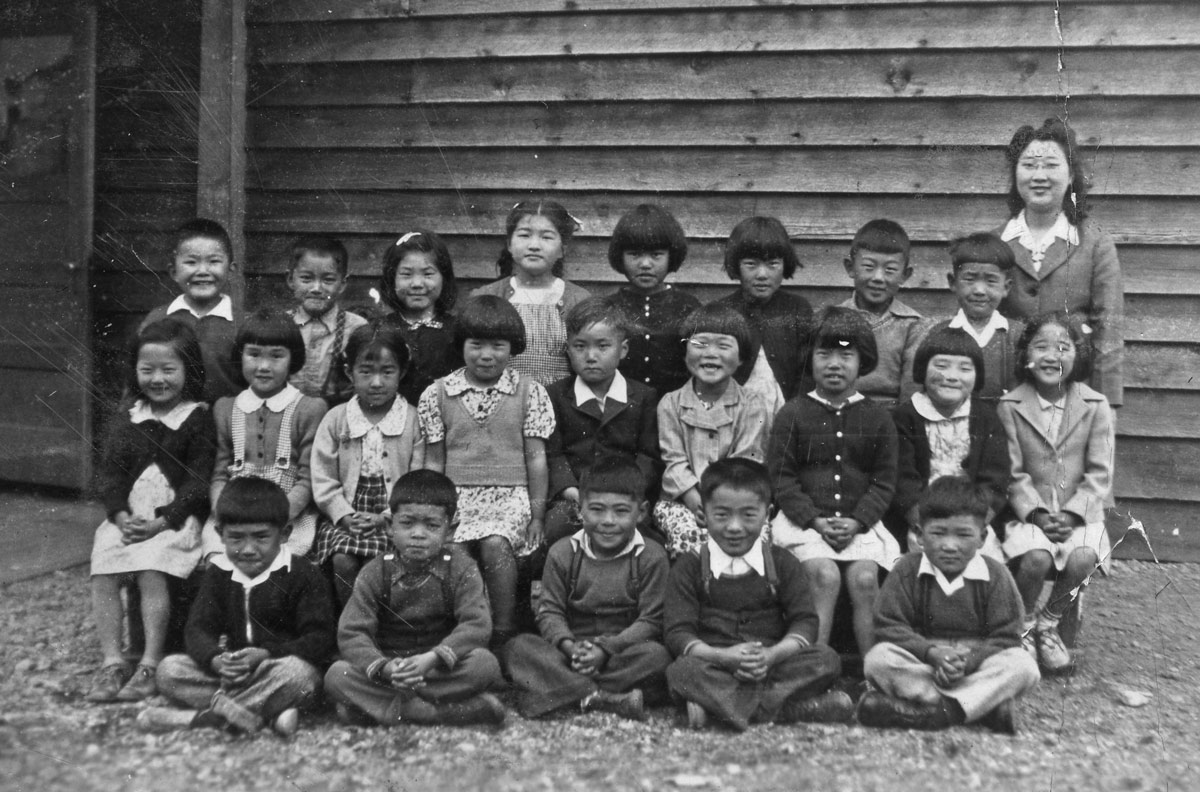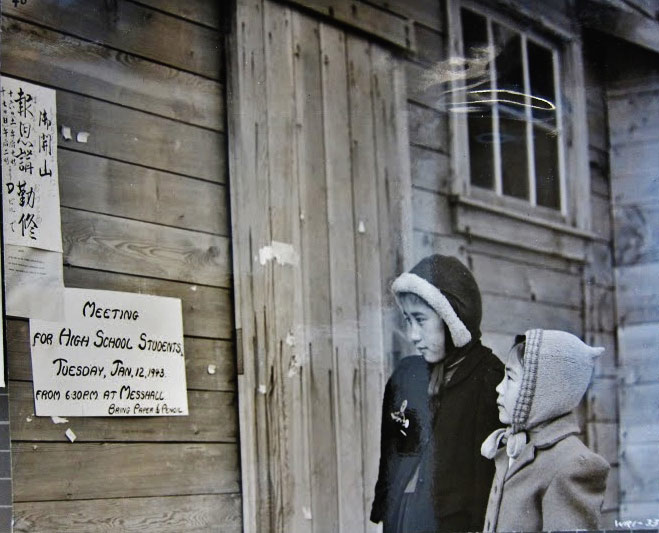The movement of Japanese from Hastings Park staging centre in Vancouver to Tashme was largely completed by October 1942. The construction of 347 houses was completed by December 1942. The population of Tashme was 2636 in November 1942.
The building of community was a preoccupation from the beginning. While the BCSC held overall authority and responsibility for the management of Tashme, the internees established committees to organize, develop and implement policy and regulations to oversee the forced removal and the building of community operations in Tashme. A Japanese Construction Committee was elected to oversee and coordinate the formation of Tashme. This committee was replaced by the Shinwa-kai in early 1943.
TASHME, BC With the relocation of evacuees in Tashme now brought to a conclusion and construction work nearing an end, a new set-up in the community committee is being planned. A special group has been chosen to study and recommend a new form of committee which will be more suited to the settled conditions than the present “Construction Committee” which has been functioning for the past few months. It is also hoped that a number of representatives will be permitted to make an inspection trip to other interior towns, to study conditions: and to establish some connection with other committees. Activities are now being carried on in Tashme itself by the Young Men’s Organization, which was set up some time ago, although the uncertain future of young single men in the towns has made this somewhat difficult.
All Families Settled. The building of houses, which now number well over 300, has been whoIIy completed and all families have been settled in the cabins, the duplexes or the apartments. The water system, which brings a tap to every three or four houses. Construction is still going forward on the baths, with plans made for one bathhouse to every fifty cabins. While electric lights have been installed in the apartment, stores and other essential buildings, it appears likely that for a long time the average resident will continue to light his house with the kerosene lamps.
Hospital Complete. Great pride is being taken in the splendid 60 bed hospital whlch is now practically complete. Medical officers here will be able to offer patients in Tashme all the benefits of a modern hospital. The sawmill which proved invaluable in providing necessary lumber for building, is carrying on, manned by twenty experienced hands. Crews are busy at wood cutting, so that there is no shortage of good fuel. And residents are continuing to enjoy the vegetables grown locally, including “otsukemono”.
In five months time this community has taken very definite shape and though it differs greatly from what the evacuees knew last winter, nevertheIess an accepted pattern of living is emerging. Vital statistics have kept pace with construction, so that among the 2;600 citizens of this mountain-sheltered plateau, 14 miles from the boundary of the coast defense zone, births and deaths have been registered. In fact a number of marriages among young people are already in the air.
from New Canadian 1942-12-06
By December 1942, the phased movement of families from Hastings Park to Tashme as the quickly constructed houses were being completed was over and a sense of community was taking root.
Tashme Now is “Our Town” by a Tashme-ite
TASHME BC. 1942 will soon be drawing to a close and another leaf of mankind's history shall be turned--a leaf that held more than its share of memorable happenings. To the Japanese people of. British Columbia, it shall be forever a marked year. To us it has meant a resignation to the forces of war, which have brought us to unfamiliar surroundings to begin life anew. And so in, Tashme, as doubtless in other centres, Niseis and the older generation will strive through the coming year to make the best of wartime existence. Once a commercial ranch, Tashme has been transformed into a "Nihon-jin" settlement, with almost three thousand people. It is a peaceful spot, lying in the centre of a level valley, surrounded on all sides by high towering mountains of the Cascade range. Indeed these mountains are the unchanging horizon to which we lift up our eyes.
A Country Town. At first, when Tashme was in its first stages, it reminded one of an early pioneer settlement carved out in a forest clearing. But today, it, is vastly changed. Row upon row of tar-papered, five-roomed houses, and the busy activity of its people meet the eye. There are tokens even of the big city, in the large apartment house for the Occidental staff, and the cross-shaped hospital. We look now upon our home as a country town, hidden away in a secluded valley, filled with people seeking to live happily. After several months of “evacuation" and adjustment, we have settled down more or less to the new "order", and are now trying to. make it as useful and pleasant as possible. Each day life goes an in much the same way, with men and young folk working at their various jobs, and the women and children trying to maintain a "homey" atmosphere despite the cramped, crowded houses.
The Mind of the People. But though the people live and work together, their; thoughts are by no means similar. Some are stlll bitter and hurt, and care not whether the community progresses or not. And out of the bitterness of their feeling; the wish to strike out blindly in return for what they feel the injustice done to them, grows discord and disharmony in the community itself. On the other hand, are those others, "taking life as it comes." They left their self-pity behind when they moved, and cheerfully tackle the issues before them, for they know the real answer to the question: "Where will grumbling, dissatisfaction, spitefuIness and self-pity get anyone in this evacuation centre?”
Probably the older generation here find life most satisfactory, for their days of fun and frolic are over, and to them a secluded, quiet life is sufficient. But what of the Niseis, the younger generation of Tashme, yearning no doubt for the city with its theatres, its roller skating, its bowling alleys, all those things they knew in the past. Their energy finds an outlet in outdoor sports, and though at times they may complain, they are doing their best to build a new happiness for themselves. Already those efforts have resulted in the formation a Youth Organization, and high hopes are held for its success in leading the way to making wartime existence in Tashme a “valuable experience.”
A year of hurt and pain has not destroyed the spirit of Christmas and the New Year here, and as Tashme lies peacefully and snow covered......
from New Canadian 1942-12-26
The First Winter
The first Tashme winter, 1942, is indelibly inscribed in the minds of all adults. Having left home in haste, with few possessions, those interned were ill prepared to cope with the snow and cold of an interior winter. Camp facilities were inadequate, and the confusion of evacuation and resettlement persisted. Shelter in the form of small wooden houses, clad in tar-paper, had been built; but they were insufficient to supply more than a rudimentary protection. Firewood was plentiful, but at first was too green to burn.
“The shacks were made of green wood. The firewood was green too. So, when you lit the fire, it would hardly burn. After you go it going—if you were lucky enough to get it going—all the water in the green timber would start to run down the walls because of the heat. The fire would go out sometime in the night and the walls would freeze. By morning, they would be covered with ice. We did not have enough blankets to keep warm, and most of us didn’t have enough warm clothing because we were not allowed to bring it with us.”
While physical discomforts continued until springtime, internees gradually came to view their position in a more objective light. With the commencement of internal organization, camp life began to settle down in a more routine pattern.
“After that first winter there were no great hardships at the camp, associations and friendships had been formed, and the camp atmosphere was much better.”
from The Presence of a Past Community: Tashme British Columbia. An article in Peoples of the Living Land. Tantalus Research Limited 1972
Tashme was one of many internment camps established by Government of Canada to house persons of Japanese descent who were forcibly removed from the protected area on the coast of British Columbia. In each camp, the establishment of a sense of community was an essential to the well being of the camps and its residents. Camp supervisors and administration addressed the housing, education, employment, municipal administration and services, recreation and security issues which enabled the development of community among the residents despite many hardships.
To understand the big picture of government actions during internment and plans for re-establishing the Japanese following the internment, the following reports provide an overview.


